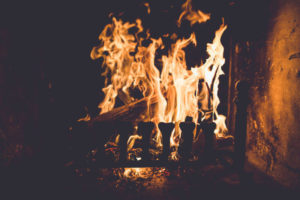Even if you have a beautiful fireplace and well-constructed and safe chimney system, it won’t matter if you can’t light a decent fire. Whether your fire is for ambiance and relaxation or to heat your home, you need to know how to light it–otherwise you’ll be looking at a long, cold winter. In order to light and burn, a fire needs three things: fuel, heat, and oxygen.
The Chimney
In order to house a fire, your fireplace needs access to oxygen. Otherwise, it will be a beautiful, empty space in the middle of your living room. Your chimney needs to support airflow, so there should be a draft, and in order to have a draft, the chimney needs to be in good shape. The best way to insure your chimney is safe and efficient, is to schedule an annual chimney inspection. To insure the chimney is clean of flammable materials and obstructions, you need to schedule regular chimney sweeps.
The Firewood
The second of three necessary elements for fires is fuel. Your wood-burning fireplace needs wood in order to burn, and it matters what type of wood you use. When freshly cut, wood is filled with water that was keeping the tree alive. When the wood is wet, or “green”, it can be difficult to light, will burn with less heat, and will produce more ash, smoke, creosote, and particulate pollution. The best firewood will be a hard-to-medium wood that has been cut and stored to dry for 3-6 months (3 months for softer woods, 6-12 months for the hardest woods). When it’s dry, it’s “seasoned”.
The Fire
Ask any avid camper, soldier, or cabin-dweller. HOW you build your fire matters as much as the fuel and igniter you have on hand. There are two tried-and-true methods that even the professionals stand behind. Using these methods, your fire will produce more heat, and you’ll find yourself stirring and adjusting the wood less often to reach the best fire.
The Log Cabin
The log cabin method looks a lot like a log cabin. The base is two thin logs with no bark placed parallel to the back of the fireplace, stove, or insert. Place them about 6 inches apart so that adequate airflow reaches the flames. Next, heap the kindling between the two logs. On top of the base logs, place two more logs perpendicular. You can add a third level with logs positions in the same direction as the base logs, then light.
The Top-Down Burn
This method, endorsed by the Chimney Safety Institute of America (CSIA) creates less smoke, more heat, and…less work!
Start by placing the largest logs facing front to back on the bottom of the fireplace. Stack 4-5 levels of logs alternating directions, moving from the largest layer, to the smallest on top. The stack should be about ½ the height of the fireplace and should have kindling on top, along with wood shavings, lint, and crumbled paper. This stack should not reach past the fireplace opening. Once built, you should be able to light the kindling, and as it burns, it will ignite the layers below.

